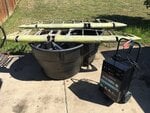cvairwerks
Staff Sergeant
The Fairchild AT-21 was made out of wood.. They made about 70 of them.
Small error here...There were actually 173 AT-21's produced along with 1 XAT-13, 1 XAT-14 and 1 XAT-21.
Skins were DuraMold, which was a phenolic resin impregnated wood sandwich. The original production parts were wet layups cured via pressure and temperature via an autoclave. Subsequent developments in adhesives, moved the process to a dry layup and RF curing, speeding production up by hundreds of hours. With the advent of the dry sheet adhesives, a spar crew could layup and cure a upper section or lower section of the center spar in under 20 minutes and have it ready for further assembly.
The forward fuselage was a steel tubing truss that ran from the nose gear to the rear spar and carried a significant amount of the structural loads. There was also a small steel tubing truss that carried the tail loads to the rear monocoque. Steel trusswork and large aluminum forgings were used to transfer gear and power plant loads to the center section spars. Ailerons, elevators and rudders were conventional aluminum rib and spar construction with fabric covering. Flaps were standard wood construction with DuraMold covers. Trim tabs were steel tubes with DuraMold covers. Size-wise, the airplane falls between a C-45 and C-47 for size and weight.
For those that are curious, here is a link to a Fairchild promotional film about the AT-21.... Also note, the first 1:40 or so shows some very early C-82 Packet taxi and flight tests.
BTW...My AT-21 project is 42-48053 and was the 2nd one built by Bellanca Aircraft.

